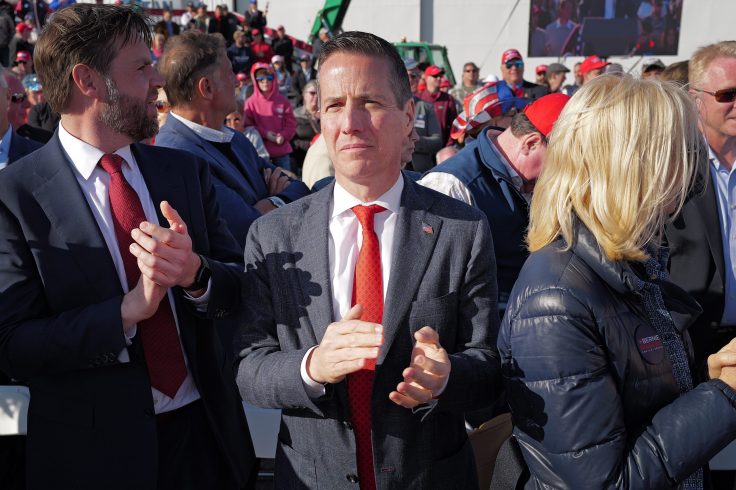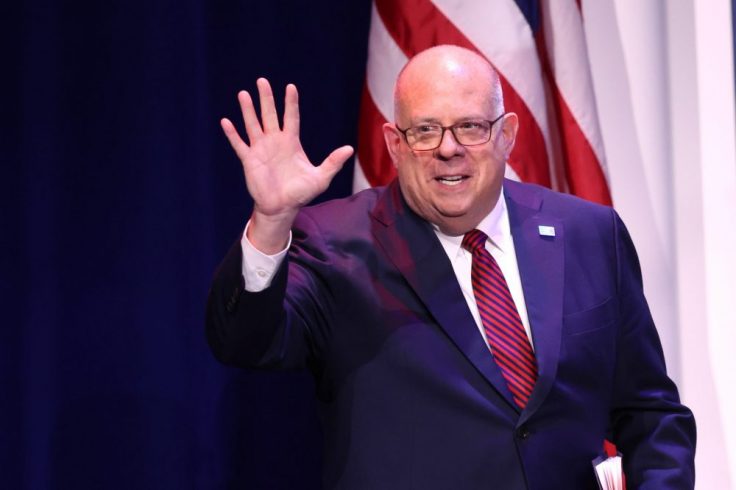Republican chances of winning control of the U.S. Senate improved Wednesday when a Washington Post poll showed Larry Hogan (R., Md.) trouncing his potential Democratic opponents by double digits. The popular former governor, known for his independence and common sense, has been supporting Israel as his Democratic rivals squabble for left-wing votes. Though Hogan remains the underdog to replace retiring Sen. Ben Cardin (D.), his successful record and unique profile will force Democrats to play defense in a blue state that they normally would be expected to win without breaking a sweat.
The Democrats have reason to be nervous. The 2024 Senate map endangers their 51-seat majority like no other recent election. Democrats hold most of the contested seats this year, including in states that Donald Trump won twice. They also hold all three seats that the Cook Political Report with Amy Walter rates as toss-ups. The most at-risk Republicans are Sens. Ted Cruz (R., Texas) and Rick Scott (R., Fla.)—and their seats are both considered "likely" holds in red states.
The geography of this Senate cycle has always favored Republicans. But recently the number of potential GOP gains has increased, thanks to President Biden's dismal job approval and to candidates such as Hogan. The decline in split-ticket voting, with states backing the same party for president and Senate, helps Republicans, too. And so does the realignment of the electorate along class lines (as measured by educational attainment) rather than ethnicity and race.
I divide the Senate races into three tiers: from the likeliest seats to turn red to outliers that could flip if everything goes the GOP's way. Here's my breakdown:
Tier One: West Virginia, Ohio, and Montana. These are the GOP's top targets. The seat in West Virginia, where Sen. Joe Manchin (D.) has announced his retirement, is practically guaranteed for Republican governor Jim Justice. Manchin is the sole statewide Democratic official in West Virginia, where Donald Trump won by around 40 points in 2016 and 2020. When Manchin retires, the state will complete its decades-long transition into a GOP stronghold.
Ohio pits incumbent Sen. Sherrod Brown (D.), now in his third term, against Republican challenger Bernie Moreno. The Buckeye State car dealer, born in Colombia, ran roughshod over his opponents in Tuesday's GOP primary, beating his closest rival by 18 points. Moreno has the endorsement of Ohio's junior senator, J.D. Vance (R.), and of former president Trump. The national GOP has rallied behind him. Trump won Ohio by 8 points in both 2016 and 2020. And Vance was one of the few Senate GOP success stories in 2022, when he won by 6 points. Brown is a skilled politician. But he's swimming against the current in a state pulled by the red tide.

Montana's incumbent senator, Jon Tester, is another talented Democrat serving his third term. His likely opponent is businessman and former Navy SEAL Tim Sheehy. I've admired Tester's personal affect and campaign skills since I covered his first Senate campaign, against GOP incumbent Conrad Burns, in 2006. And Tester has been able to thrive in a red state that voted for Trump by 20 points in 2016 and 17 points in 2020. But Sheehy, a newcomer backed by Montana Republican senator and Senate campaign chairman Steve Daines, will give him trouble. This is also the first time Tester and Trump have shared a ballot.

Tier Two: Nevada and Arizona. If Trump flips these two southwestern states in November, Democratic incumbents in Nevada and in Arizona could fall as well.
Nevada's Jacky Rosen (D.) keeps a low profile in Washington, but she defeated incumbent Republican Dean Heller handily in 2018 and is the sort of senator you'd expect to last in a state that hasn't voted for a GOP presidential nominee in 20 years.
Rosen's problem is that Nevada is changing. Trump lost the Silver State by 2 points in 2016 and 2020, but he has since overtaken Biden. Rising prices and a broken immigration system have pushed Hispanic voters toward Trump. According to the RealClearPolitics polling average, Trump is ahead of Biden by 4 points in Nevada. And his lead is consistent. The last poll that had Biden ahead was published in October. A Trump victory would boost likely GOP nominee Sam Brown, an Army veteran on his third attempt to win federal office.
In Arizona, the national GOP establishment coalesced around former television broadcaster Kari Lake. The MAGA celebrity, who lost a close race against Gov. Katie Hobbs in 2022, is the likely Republican nominee against Rep. Rubén Gallego (D.) to replace retiring Sen. Kyrsten Sinema (I.). Lake will have to win over the Republicans and independents who were leery of her two years ago. She will also need Trump to defeat Biden in Arizona. At this writing, Trump is up by 5 points.
Tier Three: Michigan, Pennsylvania, Wisconsin. In 2016, Trump broke through the "Blue Wall" of Rust Belt states that hadn't voted for a Republican for president since 1988. That same year, Republican Senate candidates won in Wisconsin and Pennsylvania. There was no Senate race in Michigan.
Trump lost the Blue Wall states in 2020. Biden beat him by about 150,000 votes in Michigan, 80,000 in Pennsylvania, and 21,000 votes in Wisconsin. Michigan Senate candidate John James, now a Republican congressman, also lost by some 90,000 votes to incumbent Sen. Gary Peters. It stands to reason that if Trump climbs over the Blue Wall in 2024, then Republican Senate candidates in these three states will follow him on their way to D.C.
According to the RealClearPolitics polling average, Trump leads Biden by 3 points in Michigan, where Rep. Elissa Slotkin (D.) is likely to face former congressman Mike Rogers (R.) in the fight to replace retiring Sen. Debbie Stabenow (D.).
Trump leads Biden by under 1 point in Pennsylvania, where GOP businessman and brilliant author Dave McCormick is running to unseat three-term Sen. Bob Casey Jr. (D.). And Trump leads Biden by 1 point in Wisconsin, where investor Eric Hovde is the likely Republican nominee against two-term incumbent Tammy Baldwin (D.).
If you add Larry Hogan to the mix, Republicans stand to win anywhere from one to nine seats in November. A GOP run could shift the balance of power in the Senate from 51-49 Democratic to 58-42 Republican. That would be the highest number of Republican senators since the 67th Congress, from 1921-1923, and the largest Senate majority of either party since the 111th Congress, from 2009-2011.
But a lot can—and will—go wrong. As it stands, Republican candidates in swing states are running behind Trump, closely trailing their Democratic opponents. Indeed, Justice and Hogan are the only two Senate candidates with leads outside the margin of error.
The closeness of the election is a reminder that Trump's lead, while persistent, is also narrow and precarious. It relies on independent voters continuing to prefer Trump to Biden, and on non-college minority voters showing up for Trump in November. If neither condition holds, then Trump's advantage may shift ever so slightly by Election Day, bringing a win for Biden and limiting GOP gains in the Senate.
Candidate performance is another reason to be skeptical that Republicans will win all three tiers of Senate seats. We've been here before, most recently in 2022, when the GOP squandered opportunities by nominating individuals who mystified or scared the public. NRSC chief Daines has put a lot of work into candidate selection and training, and so far, his strategy appears successful. Yet all it takes is an errant word or a goofy moment or a general aura of weirdness to send independents and suburbanites back into the Democrats' arms.
The 2024 candidates have something the 2022 candidates did not: President Biden on the ballot. His deep unpopularity—the public's judgment that he is not up to another term—fuels Trump's comeback and Republican hopes. We're approaching the moment when Biden's problems will become insolvable. If Biden can't improve his numbers soon, Trump will return to office with a Republican Senate. One that includes Larry Hogan.

